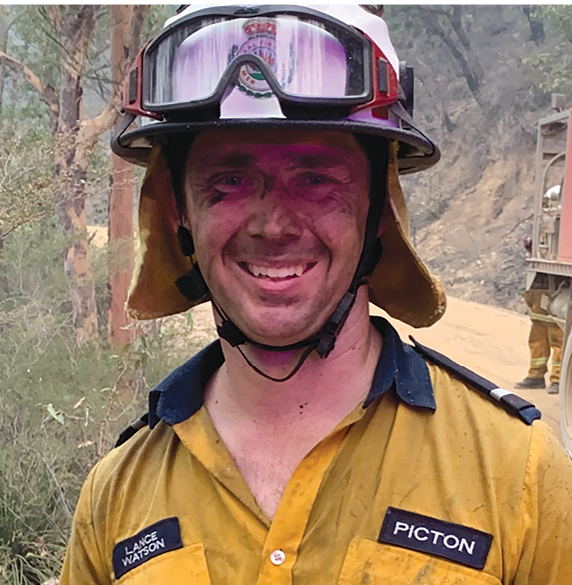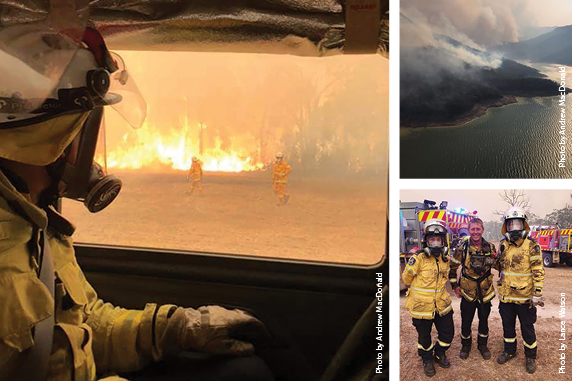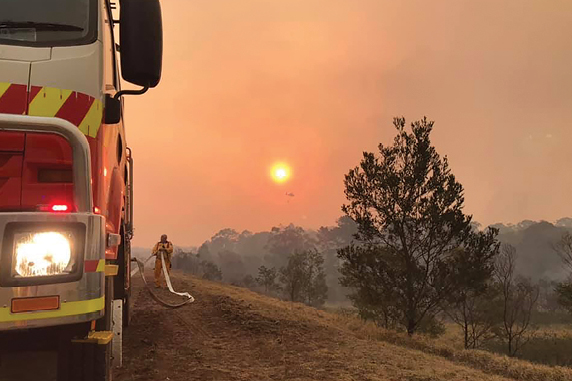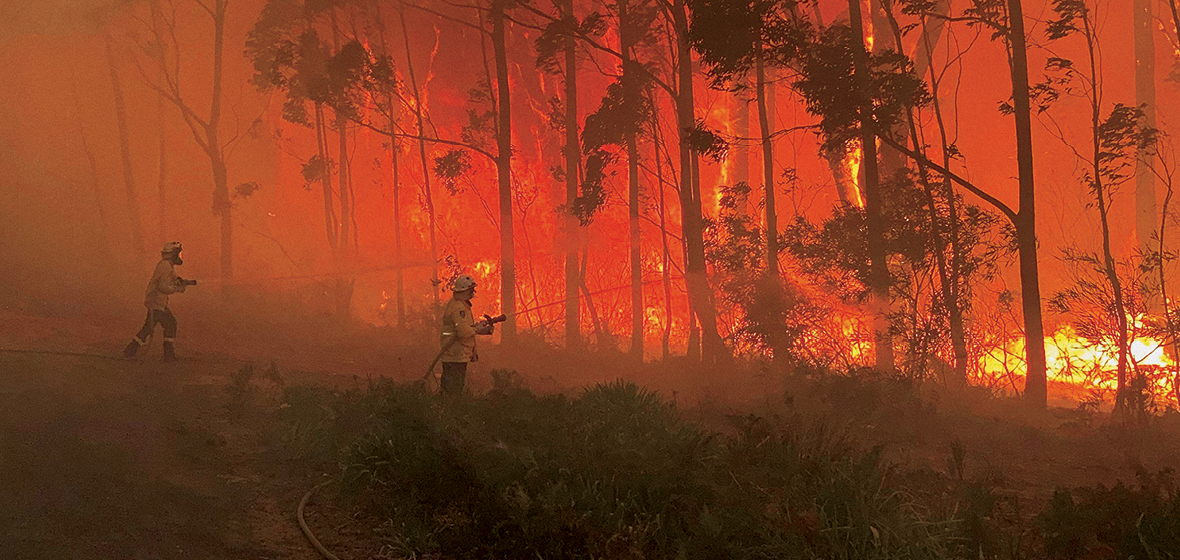More than 140 bushfires have ravaged the state so far this summer, leaving a trail of heartbreak and destruction. Putting out the flames is only the beginning – especially for insurance lawyers.
Lance Watson is exhausted. The volunteer firefighter, who is deputy captain of his local brigade, is also a partner at Caldwell Martin Cox in Picton in Sydney’s southwest. He’s spent well over 100 hours on the front line of the bushfire emergency, including Christmas Day and New Year’s Eve, while sustaining his busy practice in wills and estates.
“On one shift, we were at the airstrip at Yerranderie [a historic town in Kanangra-Boyd National Park] and it was burning pretty much on three sides of where we were. It burnt around a mountain, then the wind changed and it came crowning up on top of the mountain directly at us,” he tells LSJ.
“That was pretty hectic. We got caught out there, we couldn’t get home that night, so that shift was about 23 hours. I had to use the satellite phone to call my wife, to call the office, to call my clients and reschedule appointments because I wasn’t going to be able to get there on Monday morning.”
Watson says the key to getting through – other than drinking copious amounts of Red Bull to make up for his lack of sleep – has been simply to keep focusing on the task at hand.
“You’ve got a lot on your mind. Some people have asked if I panic or get scared, but I’m more going through the checklist in my head – where is my water supply? It is going to last? Where are my exit routes? Where is my crew? Are my comms working properly? Concentrating on that, you won’t worry as much as I suppose you would if you were just watching it coming at you.”
He’s also been keeping a close eye on his diary to ensure he’s on top of his urgent matters, adding that his colleagues and clients have been very supportive. At one point, he says, he was dictating emails to clients with a hose over his shoulder, connected to a homeowner’s pool, as he waited for the flames. At another, he was about half an hour into a meeting when he got a call asking if he could join a crew. The client, who knew he was a member of the local brigade, told him to go. He grabbed his gear and ran.
“Because it’s basically in my backyard, there’s a level of guilt if I’m not going to help. Our resources are stretched, there are only so many firefighters in the area. I do feel guilty if I’m not there.”
While Watson is on the literal front line of the crisis, many more lawyers have already begun wading into the disaster, playing roles critical to support and recovery.

State of emergency
It’s been a long and ferocious fire season in New South Wales. Back in November, the Rural Fire Service (RFS) reported that there had never before been so many bushfires burning at emergency level across the state, and conditions have not eased. At the time of writing, an estimated 98 fires are burning in NSW alone, with a further 51 wreaking havoc in other parts of the country.
Three NSW firefighters have been killed in the line of duty. Samuel McPaul, a 28-year-old volunteer who was expecting his first baby with wife Megan in May, died on 30 December when wind flipped his fire truck at the Green Valley blaze east of Albury. Geoffrey Keaton, 32, and Andrew O’Dwyer, 36, both died when their truck rolled after being hit by a falling tree in the Picton area, southwest of Sydney.
At least 25 other people have died – 17 from NSW, five from Victoria and three from South Australia – as flames razed an estimated 1,500 homes and almost 5 million hectares of land.
The scenes on television and in newspapers are nightmarish. Towns shrouded in smoke. Red and black skies. Decimated landscapes. Ash-covered locals, terrified holidaymakers, traumatised wildlife. Long convoys of fire trucks.
The crisis has prompted Premier Gladys Berejiklian to declare a state of emergency on three separate occasions so far, enabling the RFS to exercise extraordinary powers to protect life and property, including coordinating government resources, shutting down essential utilities, and ordering evacuations.
“Declaring this state of emergency is vital to the safety of communities in NSW as we face the most devastating bushfire season in living memory,” she said before the most recent state of emergency in early January.
“We don’t take these decisions lightly, but we also want to make sure we’re taking every single precaution to be prepared.”
Boots on the ground
Putting out flames and protecting lives and property are the first steps in what will be a long recovery. The Insurance Council of Australia (ICA) has declared three bushfire “catastrophes” so far this season, with total insurance losses estimated at more than $700 million by mid-January and rising quickly. However, it warns this figure is likely to rise sharply as more householders and business owners lodge claims.
“The catastrophe declaration means claims from these bushfires will be prioritised by all insurers and they will be focusing on reducing the immense emotional and financial stress experienced by residents and businesses,” said Karl Sullivan, ICA’s Head of Risk and Operations, in a statement.
Under the declaration, ICA has activated its disaster hotline to assist policyholders, mobilised a team of disaster recovery specialists to support affected communities, and established an industry taskforce to identify insurance-related issues as they arise in the hope of resolving them as quickly as possible.
Legal Aid NSW is also bracing for a sharp increase in insurance-related matters in coming months.
“There will definitely be an increase in matters, one at a time, but they will come,” says Jo Evans, a senior solicitor in the consumer law team.
“Word will get out in a community, so if you’re helping one person, you’ll help their friend, and they will recommend you to others. Essentially, we take what comes.”
Her colleague Ma’ata Solofoni, who specialises in disaster recovery and insurance law, has personally visited bushfire-affected communities around Coffs Harbour, Port Macquarie and Taree.
“We’re still early in the recovery phase, so we’re still mostly just attending community meetings and getting the word out to the affected communities that we’re available to provide legal assistance,” says Solofoni.
“We’re providing information about lodging claims, what to expect and financial hardship. The current bushfires are not like any we’ve had before – they’re so widespread that the response has been different for previous bushfires and natural disasters. Usually, a disaster recovery centre is set up for several weeks, where we would be stationed along with other government agencies.”
Since September, Legal Aid NSW solicitors have attended about 19 mobile recovery visits, organised by the Office of Emergency Management, as well as community meetings organised by local councils and other groups. Solofoni anticipates many more meetings across the state in the months to come.

Trauma and recovery
As communities become safe enough for residents to return, a second wave of recovery will commence. Of course, many insurance claims will resolve seamlessly. Solofoni says one woman she spoke to recently had her insurer assess the property and a lump sum was paid out in about a week. However, roadblocks often arise in cases when clients are traumatised, underinsured, or don’t understand the process.
“You’ve got to take it slowly and just take as much information as you can get at the time. You’ve got to be really careful about re-traumatising the client – because they’ve already been through a trauma, they’re not thinking as clearly as they would otherwise. My experience is you just have to sit and listen and can pick out the bits of information you need. Some clients you might ask directly, but somebody who is experiencing trauma, you might have to go about it in a roundabout way,” says Solofoni, noting that problems commonly occur when clients are asked to itemise all of their possessions.
“You don’t want to make it an ordeal for them. You might have to go back to an insurer and say this is an exceptional circumstance. It’s not your everyday property damage, it’s a natural disaster. The insurer has a duty of good faith towards their member. If the client can’t itemise everything, you can give background on a client – if they’ve been there for 30 years – to show the extent of the loss.”
Self-care for lawyers is an essential part of this process, especially when it comes to issues of vicarious trauma. Evans and Solofoni agree that debriefing with colleagues and planning time off to decompress are critical when tackling a crisis of this magnitude, especially when dealing with traumatised clients.
“Being aware that it’s a potential issue to start with, and looking after each other, is really important,” says Evans.
“Our solicitors have been affected by it in the past. We also have access to a certain number of hours of counselling, so if we see a colleague affected by something, we encourage them to access it.”

Supporting self-advocacy
The cost of repairing or rebuilding property isn’t the only issue that will affect those in the fire zones. Alexandra Kelly, Director of Casework at the Financial Rights Legal Centre, warns that many people will also face issues with things like tenancy, employment, and access to Centrelink services in the aftermath. It’s why education is critical, she says. The organisation receives about 9,000 calls a year for assistance and most of its work is in providing information to empower people to tackle the system themselves.
“We normally are there six months or 12 months down the line after a disaster still working on matters. We aim to do about 40 insurance cases a year, but our funding is limited. That’s why we want to give as much advice as possible and the rest is triaging information,” she tells LSJ.
“We deal with a lot of frequently asked questions. Insurance affects everyone from the really vulnerable to the people who are willing and able to self-advocate, so we provide as many tools as we can to assist them and then take on casework for those who really can’t navigate the system.”
Kelly, who has worked in insurance for 12 years, says she’s seen insurers put clients through some extraordinary hoops. For example, she’s seen them offer to pay for replacement items exclusively through gift cards instead of making a cash payment, or book customers into alternative accommodation for just three weeks at a time even though rebuilding their home may take up to six months. At times, she says, insurance law has been combative and adversarial with “black-letter lawyer kind of thinking”.
However, she notes the industry learnt a lot from the Black Saturday bushfires that hit Victoria in 2009, which claimed 173 lives in a single day and prompted a royal commission.
“Now they do more in-house and certainly their language has improved. Years ago, you would see words like ‘declinature’ – clients don’t know what that means,” she says. “There is also much greater awareness of trauma.”
When the dust settles
Insurance Australia Group Limited, which owns brands such as NRMA and CGU, is the largest general insurance company in Australia and has the biggest exposure to the current crisis. It has already received more than 2,800 bushfire-related claims since the beginning of September, at a rapidly increasing rate. It’s just one of the many insurers bracing for impact in the days, weeks and months to come.
“We’re doing all we can to help those affected by the devastating bushfires across the country,” says Luke Gallagher, Executive General Manager Short Tail Claims.
“As always, our priority is [ensuring] the safety of our customers and helping them recover as quickly as possible.”
He explains the company’s major events claim team will be heading into affected areas as soon as it is safe to do so, together with assessors and builders who can help get the ball rolling as quickly as possible. It has also activated a disaster response customer support program where customers can receive free counselling by a team of psychologists experienced in providing post-incident support.
“It’s important that insurers and all support services do everything we can to help these communities,” Gallagher tells LSJ. “[We] encourage anyone supporting our customers to help them contact us [and] lodge their claim so we can provide immediate support and help them begin their recovery.”




